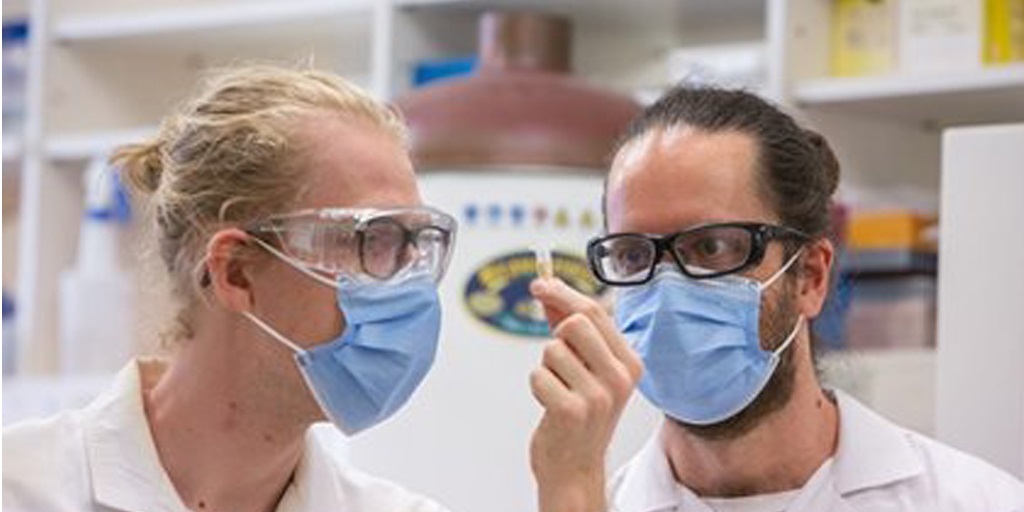
Micro-scale mash brewing could lead to new beer styles

Scientists at the University of Queensland have developed a micro-scale mash method that they say could be used to identify barley quality earlier, and in turn develop new beer styles and prompt better understanding of brewing on a molecular level.
PhD candidate Edward Kerr and Associate Professor Ben Schulz of The University of Queensland were investigating the profiles of proteins within the mashing process, and discovered a more efficient small-scale method to analyse the activity, and thus the quality of barley and its suitability for the brewing process.
“We were doing mash proteomics [large-scale protein studies] at a 23L Braumeister scale as a standard method,” Kerr told Brews News.
“We’d done it all, submitted a paper, but the reviewers wanted us to validate whether each protein’s change in abundance was caused by time or increase in temperature – with the data we had it was not possible to differentiate between the two.”
The UQ team would have had to repeat the 23L brew many times at different temperature steps to determine this.
“It would require us to do a lot more brewing, more than 10 more brews at 23 litres each and using five kilos of malt each time. We would have been able to do it but we thought maybe we could do it at a smaller scale.”
Kerr tested it on a 1ml scale needing only 200mg of malt and found that results were consistent with a large scale, without the need for specific equipment.
“The proteome [set of proteins in the barley] was consistent as were the amino acid and sugar profiles, it was all equivalent between the 23L scale and 1ml,” he explained, although he clarified there were minor differences with the wort gravity.
As the paper explained, brewing processes, both large scale and craft, are time-consuming, ingredient-intensive, and require specialised technical equipment not typically found in research laboratories, let alone breweries themselves.
But the new method could become both a useful way, primarily of determining barley quality in the malting process at a much earlier stage, but also, according to supervisor Associate Professor Ben Schulz, it could prompt brewers to become “more adventurous” with brewing conditions and potentially lead to new beer styles.
Commercial applications
When developing new methods at the research level, it’s hard to say what the potential commercial applications could be, said Kerr.
“What we do in terms of proteomics wouldn’t have much direct impact in a brewery, but could quite likely benefit barley breeding programs.
“There’s a lot that goes into barley breeding and accreditation for malting and this would allow easier and quicker understanding of quality traits.
“At this microscale testing single seeds at a time, to try newly-developed barley and it’s got a real application for breeders and that will hopefully include downstream.”
From a brewing standpoint, 1mL may be a bit too small for brewery based experiments into different malt combinations in the mashing process, but even a slightly larger test would enable malt to be tested within beer without having to put on even a small batch brew.
“This gives you the ability to test recipes at a smaller scale – maybe more like 500mLs at large scale, thus avoiding large wastage,” said Kerr.
“You might spent all this money on malt and throw it down the drain, but a small scale thing like an Eppendorf or a Falcon tube could be worth looking into, because these tests can be performed using common laboratory benchtop shakers, allowing for high throughput mashing and easy sample replication for analysis.”
Research into brewing
Developing more efficient experimentation methods is not the only thing going on at UQ.
The researchers also received a grant to purchase a nano-brewery which they are housing in a completely new building.
“Obviously COVID happened though, so we’re going to move it soon, but we are imminently getting the brewery together, there’s three 100L mash and lauter tuns and eight 50L fermenters. It will be a decent size for experiments,” said Kerr.
The brewery will be used in several courses, including chemical engineering, microbiology and biochemistry and agricultural courses.
But the researchers industry partnership with Newstead Brewing Co. will not be left by the wayside.
“Well keep working with Newstead as they have larger scales so we can look at commercial viability – there are a lot of benefits of working with Newstead and we have a really good relationship. “We’re still brewing with wild yeast, and they help us propagate yeast, and it helps us to keep our finger on the pulse and see what issues they have so we can better understand their problems for the wider community.”



